2021-01-01 • Influence of simulation params on connection test
Contents
2021-01-01 • Influence of simulation params on connection test¶
Here for the first time we run the entire workflow / ‘loop’ in one function (biology & imaging simulation, plus connection test). We then call this function with varying parameters, to test thei influence how well the connection test performs.
We stimulate the neuron with multiple spike trains, but only test the connection with one spike train (because it’s easier and faster), for now.
Setup¶
from voltage_to_wiring_sim.support.notebook_init import *
Preloading:
- numpy … (0.10 s)
- matplotlib.pyplot … (0.22 s)
- numba … (0.30 s)
Importing from submodules … ✔
Imported `np`, `mpl`, `plt`
Imported codebase (`voltage_to_wiring_sim`) as `v`
Imported `*` from `v.support.units`
Setup autoreload
v.print_reproducibility_info()
This cell was last run by tfiers on yoga
on Sat 02 Jan 2021, at 00:25 (UTC+0100).
Last git commit (Fri 01 Jan 2021, 23:38).
Uncommited changes to:
?? notebooks/2020_12_30__vary_params.ipynb
Base parameters¶
default_sim_params = v.N_to_1_simulation.default_params
v.pprint(default_sim_params)
N_to_1_SimParams
----------------
time_grid = {'duration': 600, 'start': 0, 'timestep': 0.0001}
num_incoming_spike_trains = 15
spike_rate = 20
Δg_syn = 8E-10
τ_syn = 0.007
neuron_params = {'C': 1e-10, 'a': 30.0, 'b': -2e-09, 'c': -0.05, ...}
imaging_spike_SNR = 10
(All quantities are in unprefixed SI units: second, Hz, Farad, Siemens …. Pretty printing, in human readable units, is not here yet).
def sim_and_test(params, zoom_start=1 * second):
v.fix_rng_seed()
sim_result = v.N_to_1_simulation.simulate(params)
zoom_window = v.TimeGrid(start=zoom_start, duration=1 * second,
timestep=params.time_grid.timestep)
v.N_to_1_simulation.plot(sim_result, zoom_window)
plt.show() # don't wait till function has completed to show plot.
spike_train = sim_result.spike_trains[0]
window_duration = 100 * ms
STA = v.calculate_STA(sim_result.VI_signal, spike_train, window_duration)
test_data, test_summary = v.test_connection(
spike_train,
sim_result.VI_signal,
window_duration,
num_shuffles=100,
)
fig, (left_ax, right_ax) = plt.subplots(ncols=2, **v.figsize(width=700, aspect=3))
v.plot_STA(STA, left_ax)
left_ax.set_ylabel("STA of VI signal (mV)")
v.connection_test.plot(test_data, ax=right_ax)
plt.show()
v.pprint(test_summary)
sim_and_test(default_sim_params)
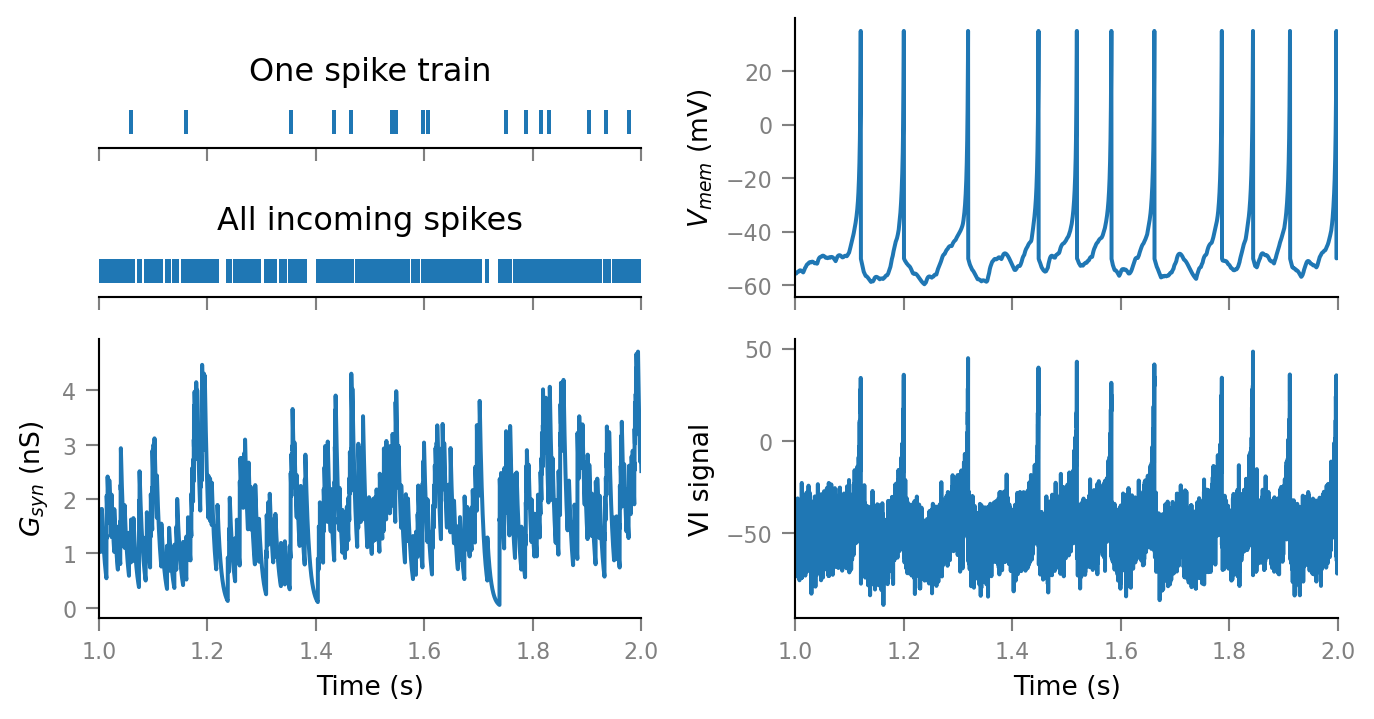
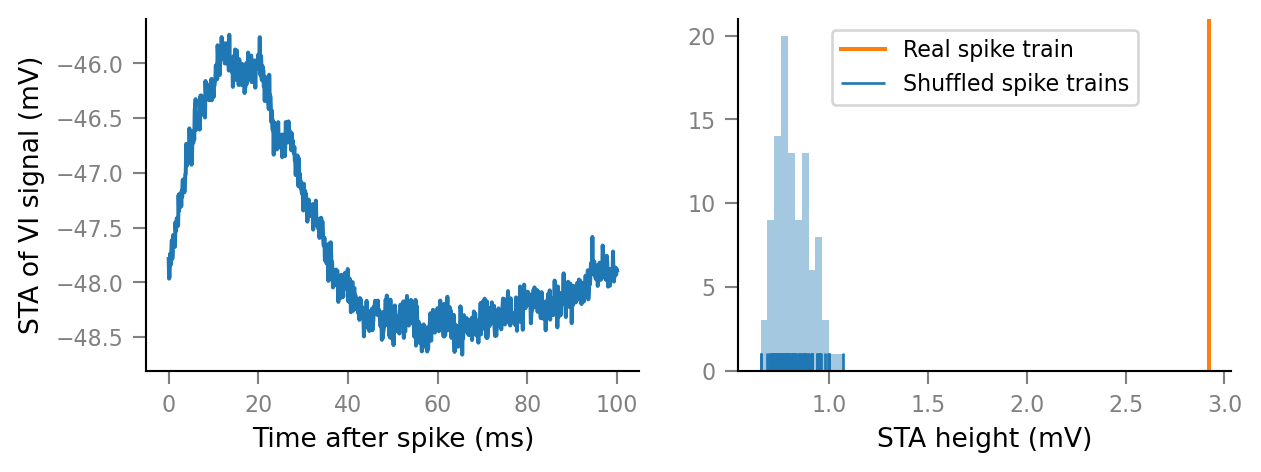
ConnectionTestSummary
---------------------
p_value = 0.01
p_value_type = '<'
relative_STA_height = 3.571
Short recording duration¶
from copy import deepcopy # 'deep' to also make a copy of `time_grid`
sim_params = deepcopy(default_sim_params);
sim_params.time_grid.duration = 30 * second
sim_and_test(sim_params)
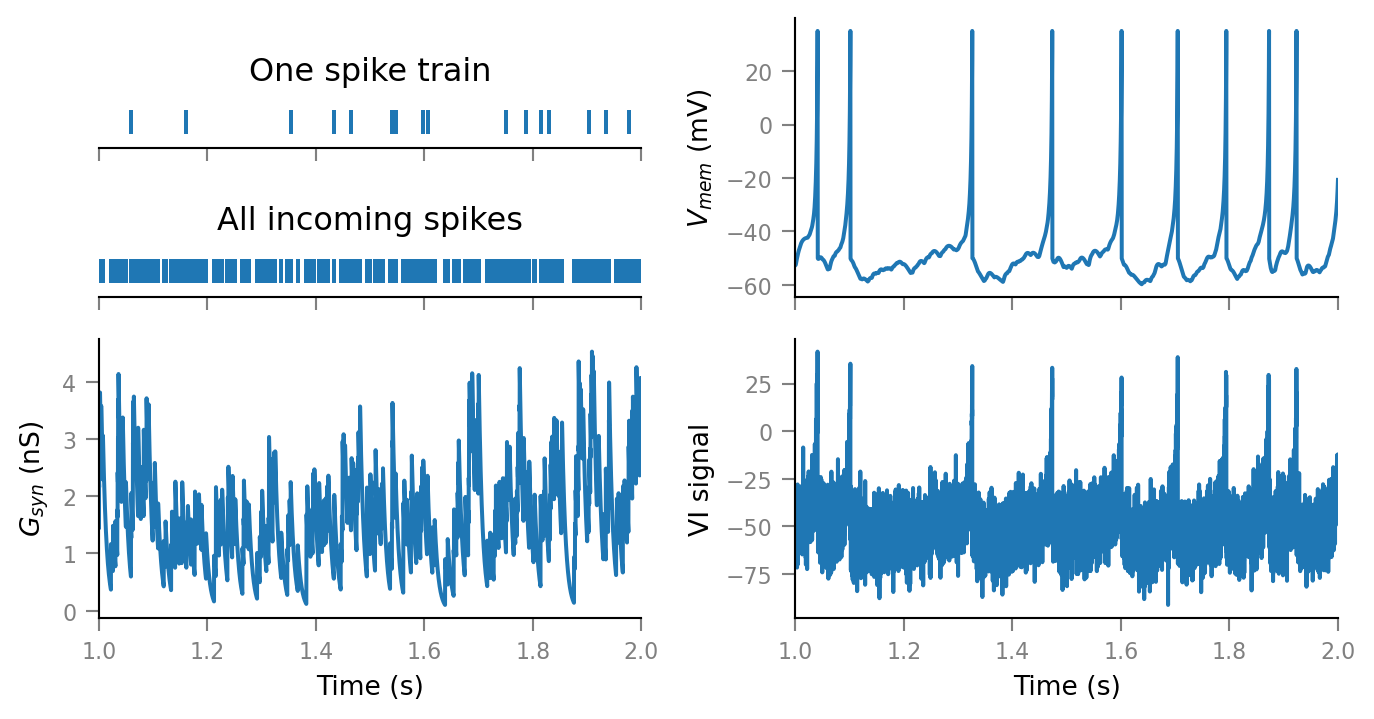
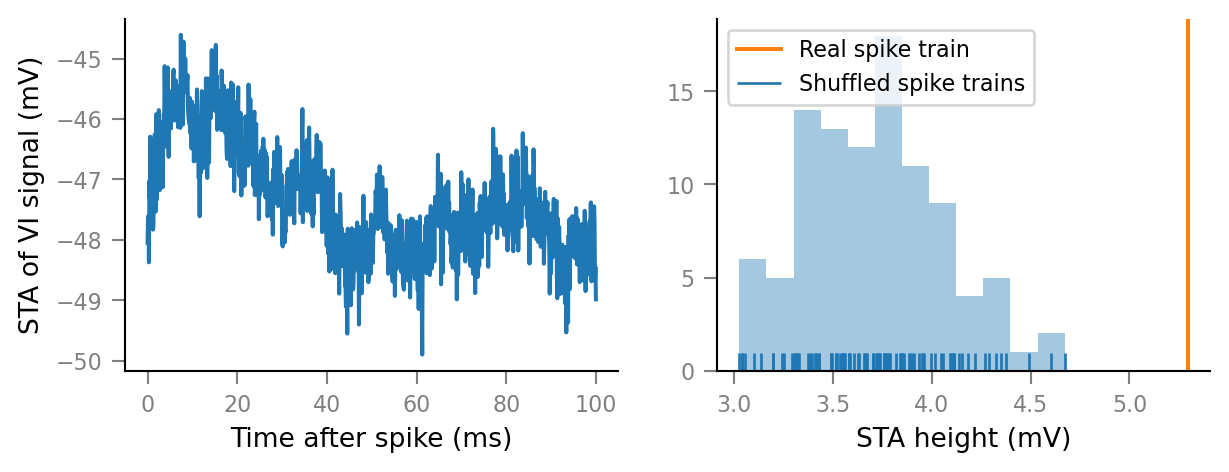
ConnectionTestSummary
---------------------
p_value = 0.01
p_value_type = '<'
relative_STA_height = 1.428
Still a PSP visible and the connection test can still find that the spike train is connected; but less convincing.
Low number of incoming spike trains¶
sim_params = deepcopy(default_sim_params)
sim_params.num_incoming_spike_trains = 5
sim_and_test(sim_params)
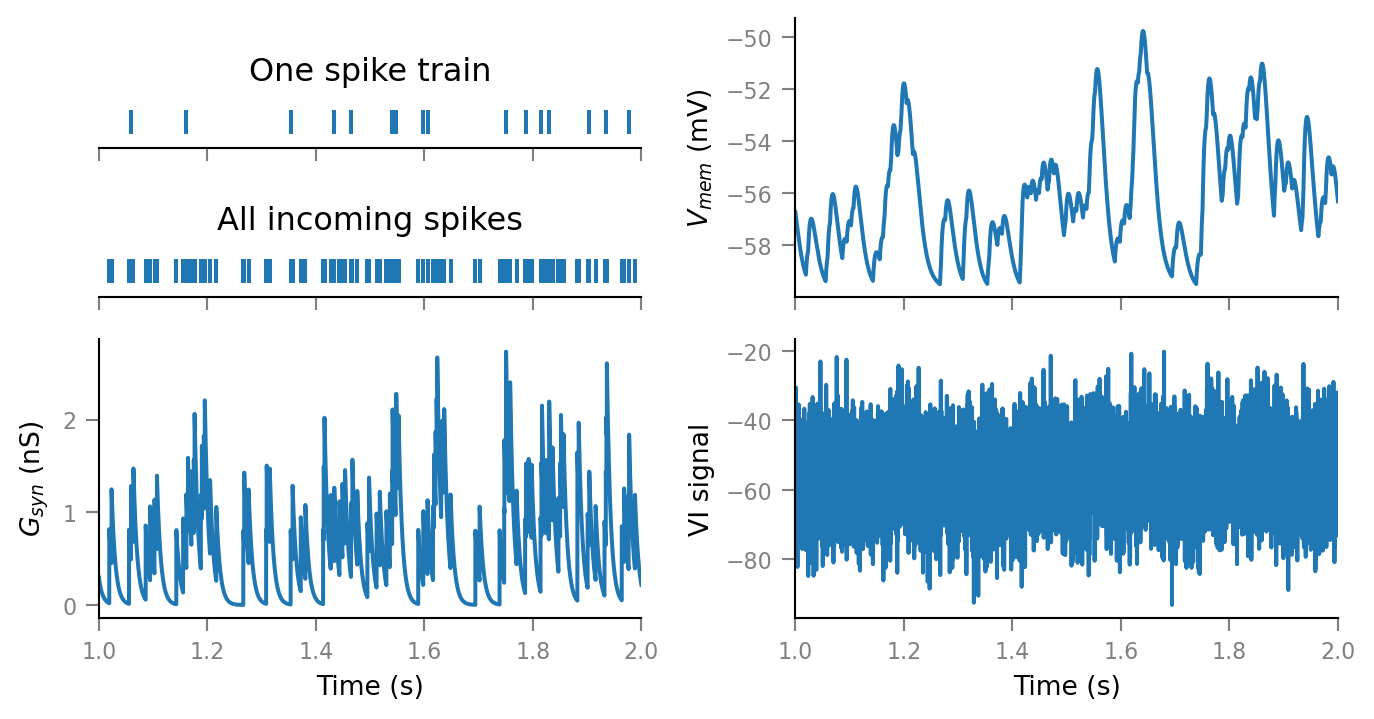
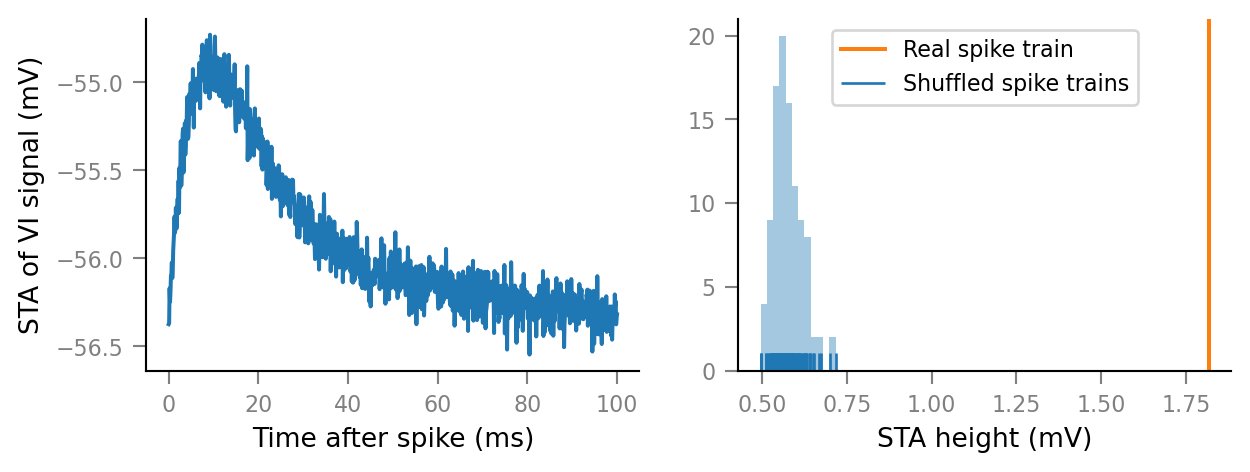
ConnectionTestSummary
---------------------
p_value = 0.01
p_value_type = '<'
relative_STA_height = 3.157
No spikes (not enough input); but still a PSP.
Note though that the STA shape is different now: no after-hyperpolarisation because no spikes.
Fast spiking¶
sim_params = deepcopy(default_sim_params)
sim_params.spike_rate = 60 * Hz
sim_and_test(sim_params)
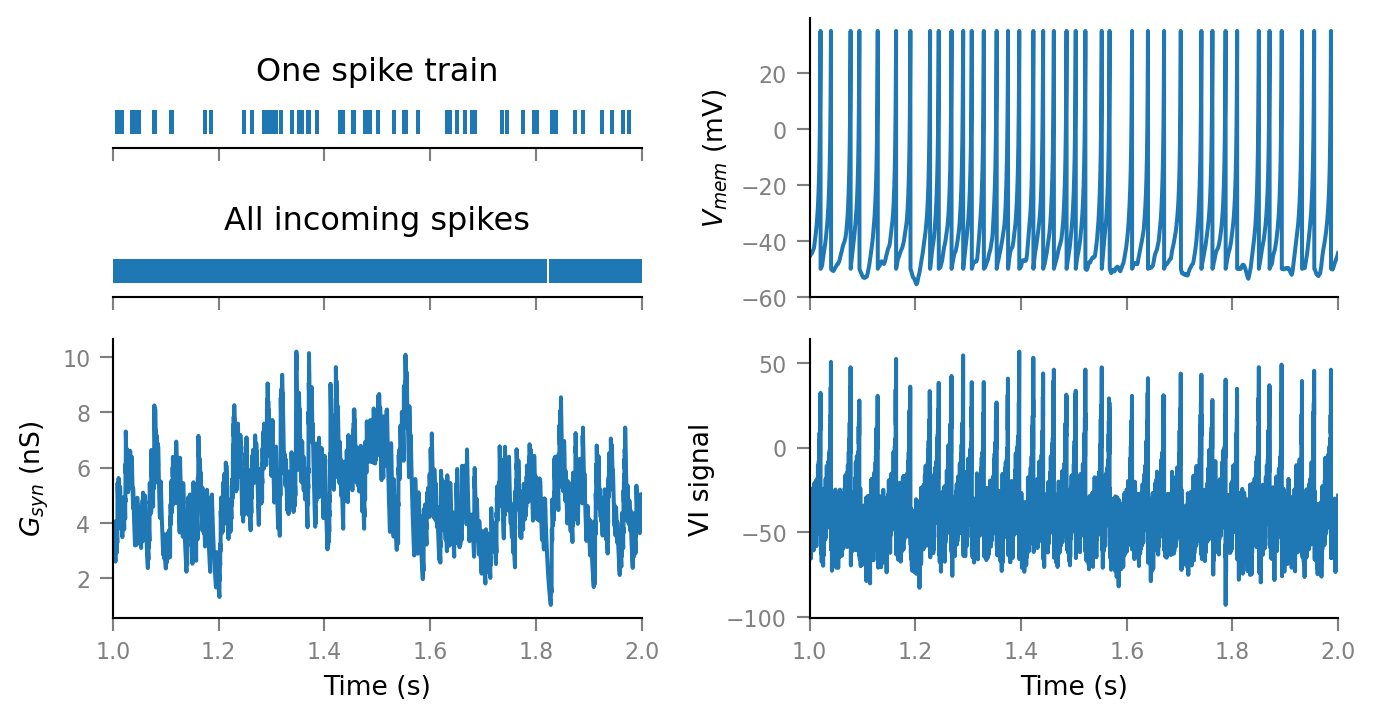
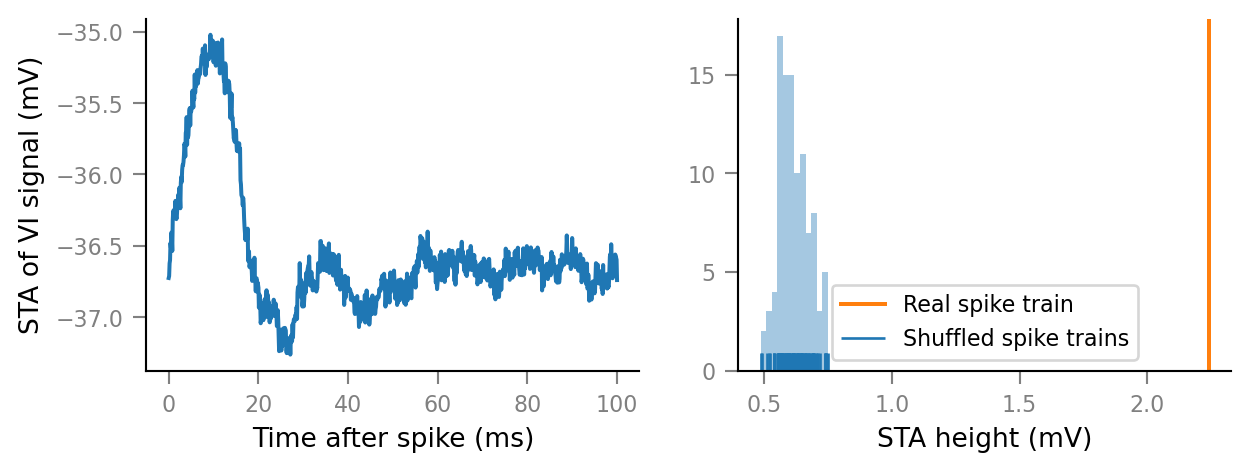
ConnectionTestSummary
---------------------
p_value = 0.01
p_value_type = '<'
relative_STA_height = 3.632
Interesting: STA shape is more time-compressed.
There’s maybe even some oscillation visible?
Noisy imaging¶
sim_params = deepcopy(default_sim_params)
sim_params.imaging_spike_SNR = 1
sim_and_test(sim_params)
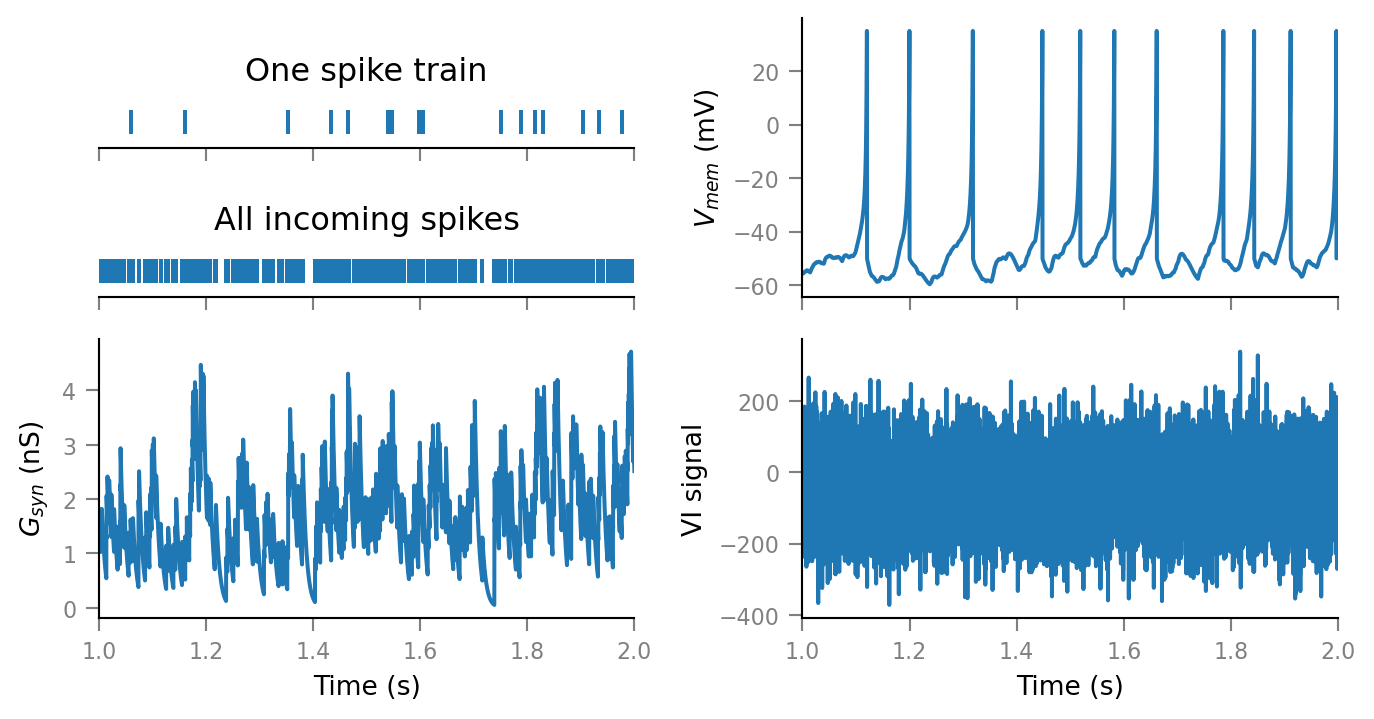
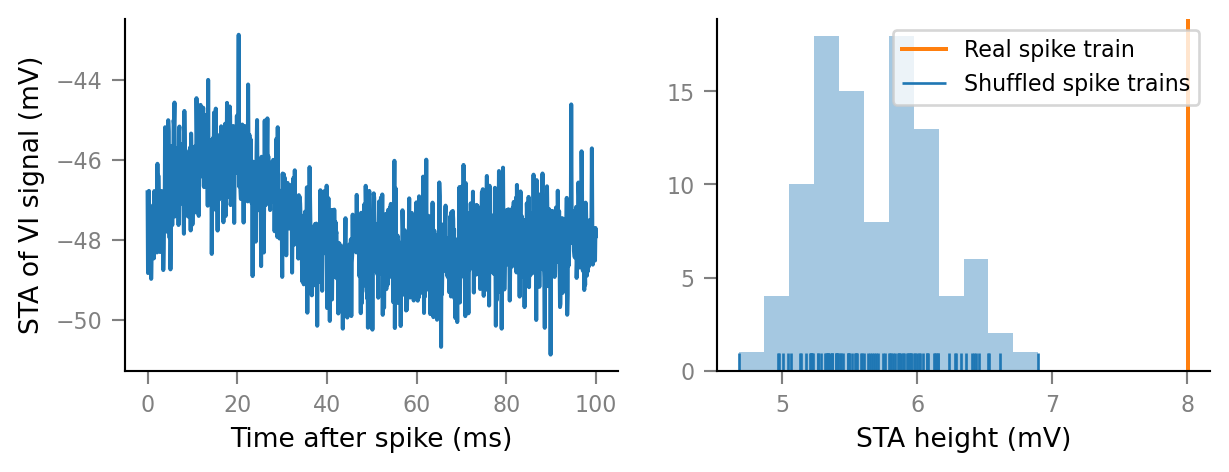
ConnectionTestSummary
---------------------
p_value = 0.01
p_value_type = '<'
relative_STA_height = 1.405
Interesting: with strong noise (here: as strong as spike height), we can still resolve the PSPs.
Noisy & short recording¶
sim_params = deepcopy(default_sim_params)
sim_params.time_grid.duration = 2 * minute
sim_params.imaging_spike_SNR = 2
sim_and_test(sim_params)
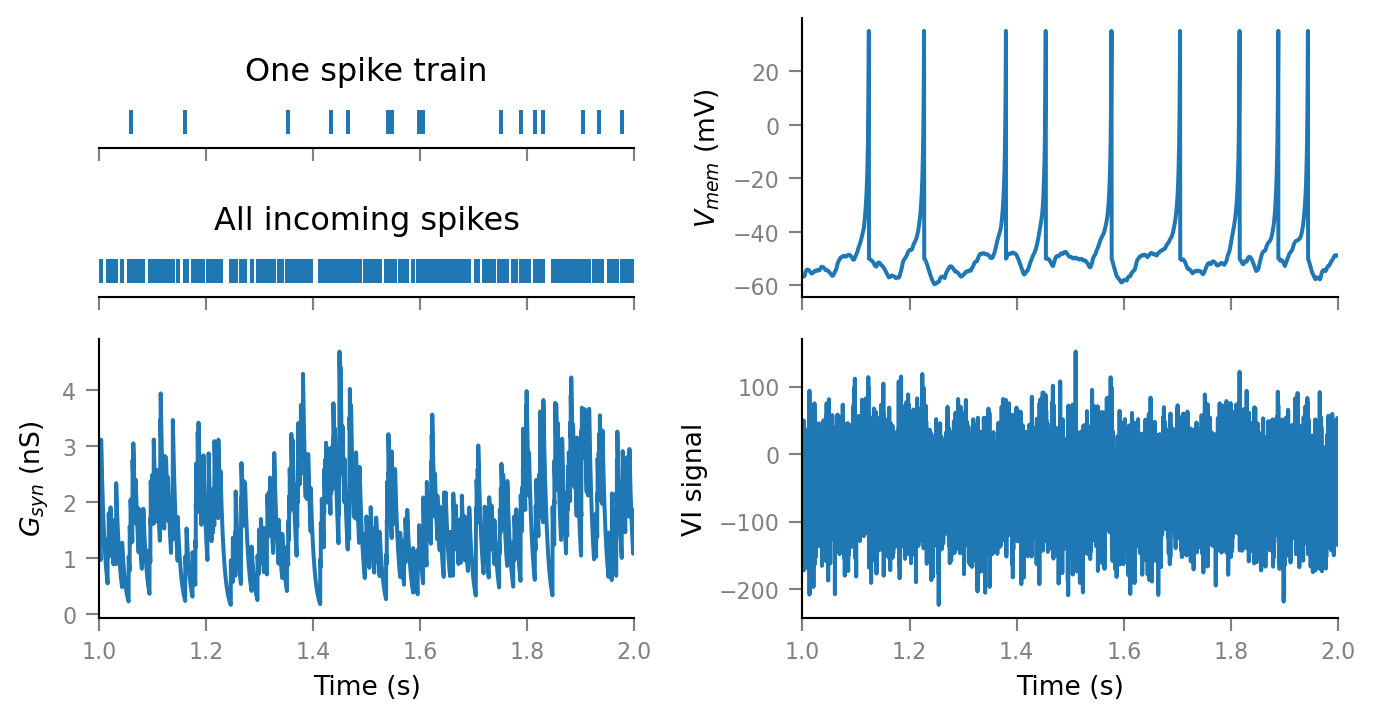
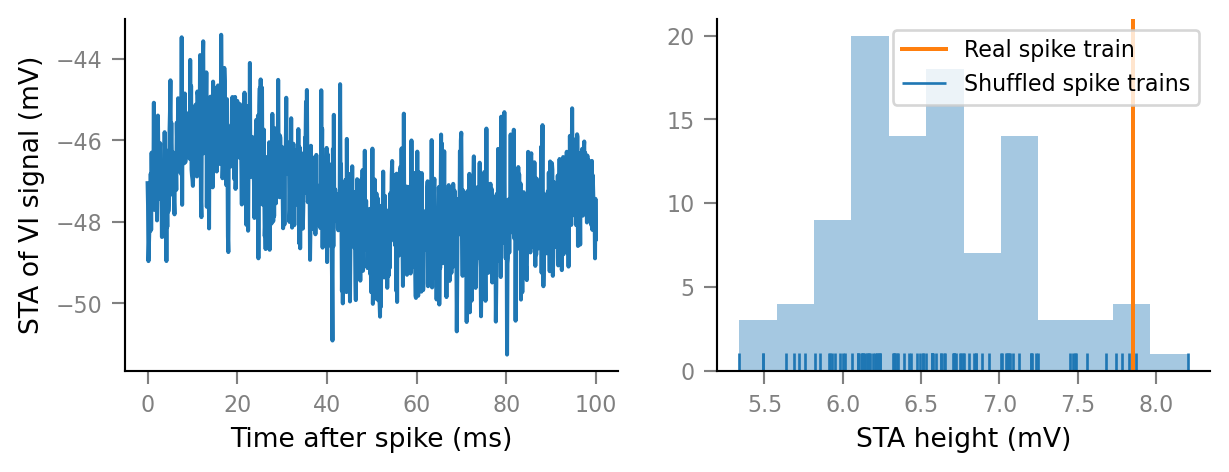
ConnectionTestSummary
---------------------
p_value = 0.02
p_value_type = '='
relative_STA_height = 1.195
..but only when our recording is long enough.
Note that the PSP is still vaguely visible in the STA, however.
Just for fun: no noise¶
sim_params = deepcopy(default_sim_params)
sim_params.imaging_spike_SNR = np.inf
sim_and_test(sim_params)
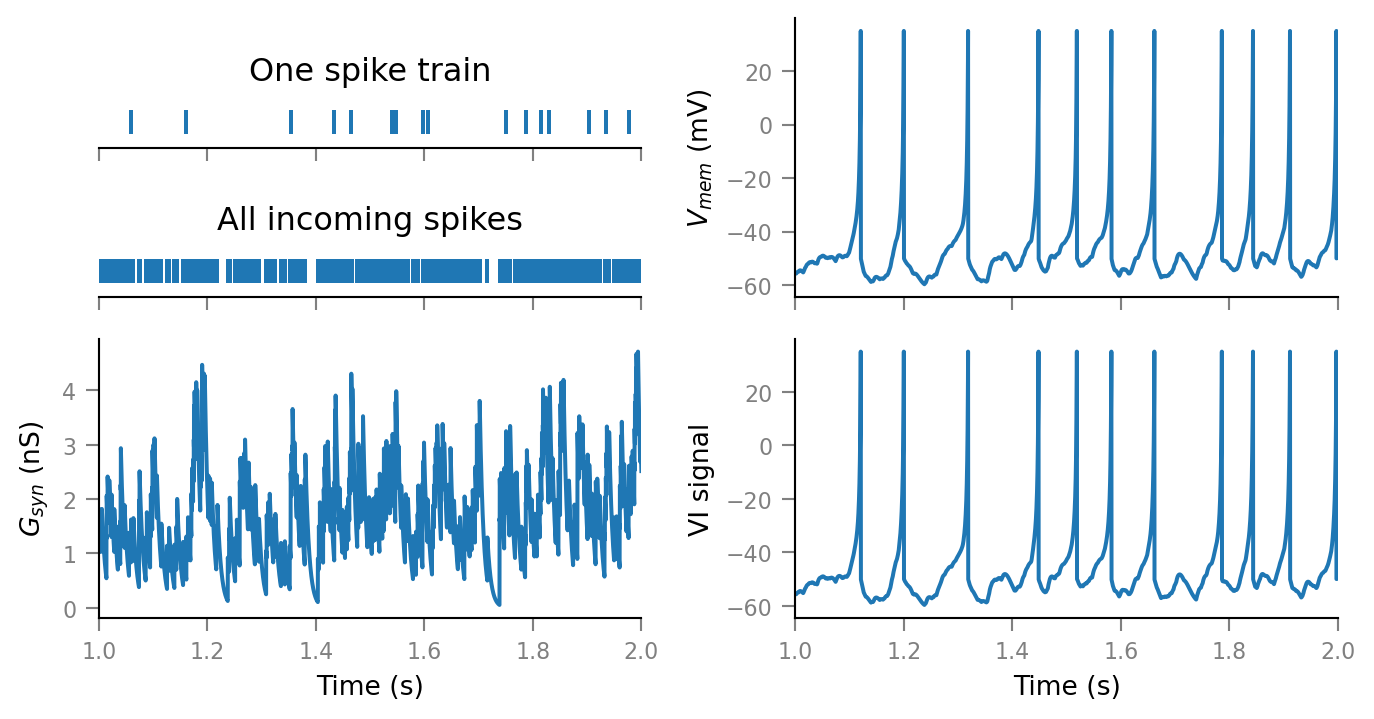
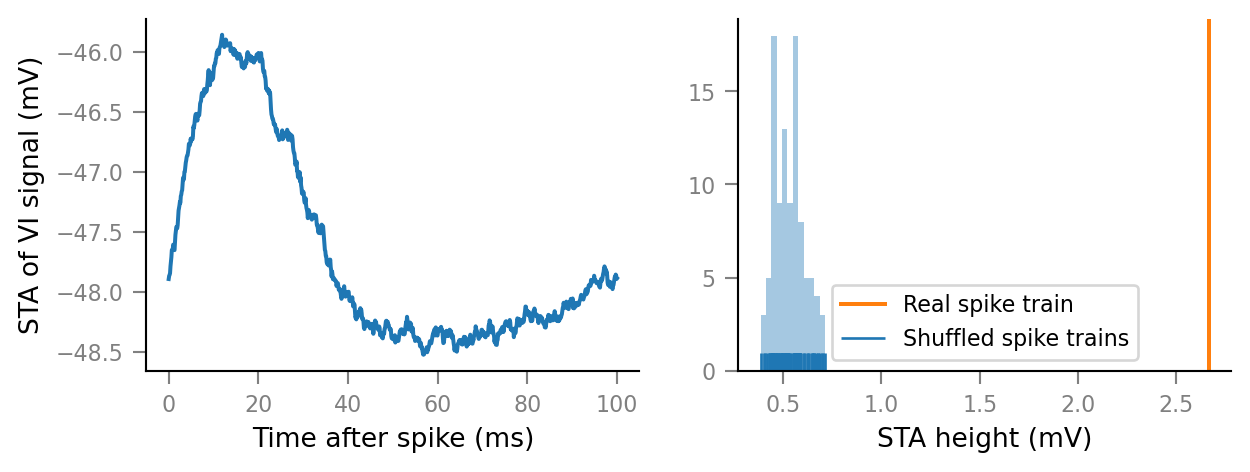
ConnectionTestSummary
---------------------
p_value = 0.01
p_value_type = '<'
relative_STA_height = 5.006
Reproducibility¶
v.print_reproducibility_info(verbose=True)
This cell was last run by tfiers on yoga
on Fri 01 Jan 2021, at 23:00 (UTC+0100).
Last git commit (Fri 01 Jan 2021, 22:59).
Uncommited changes to:
?? notebooks/2020_12_30__vary_params.ipynb
Platform:
Windows-10
CPython 3.8.3 (C:\conda\python.exe)
Intel(R) Core(TM) i7-10510U CPU @ 1.80GHz
Dependencies of voltage_to_wiring_sim and their installed versions:
numpy 1.19.2
matplotlib 3.3.2
numba 0.51.2
seaborn 0.10.1
scipy 1.5.2
scikit-learn 0.23.2
preload 2.1
py-cpuinfo 7.0.0
nptyping 1.3.0
tqdm 4.55.0